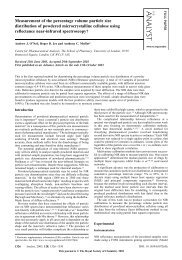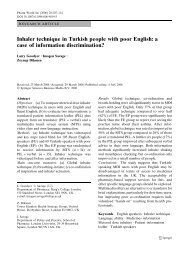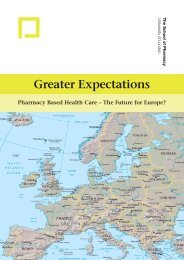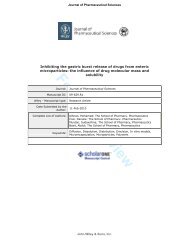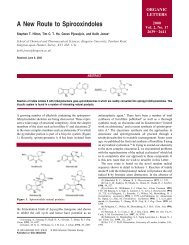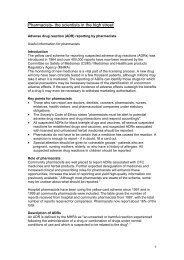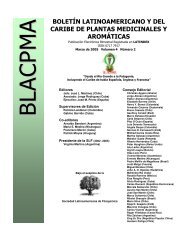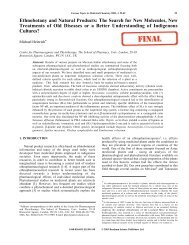SynArfGEF is a guanine nucleotide exchange ... - Pharmacy Eprints
SynArfGEF is a guanine nucleotide exchange ... - Pharmacy Eprints
SynArfGEF is a guanine nucleotide exchange ... - Pharmacy Eprints
You also want an ePaper? Increase the reach of your titles
YUMPU automatically turns print PDFs into web optimized ePapers that Google loves.
<strong>SynArfGEF</strong> <strong>is</strong> a <strong>guanine</strong> <strong>nucleotide</strong> <strong>exchange</strong> factor for Arf6 and localizes preferentially at<br />
postsynaptic specializations of inhibitory synapses<br />
Masahiro Fukaya 1 , Akifumi Kamata 1 , Yoshinobu Hara1, Hideaki Tamaki 1 , Osamu Katsumata 1 ,<br />
Naoki Ito 2,3 , Shin’ichi Takeda 2 , Yutaka Hata 4 , Tatsuo Suzuki 5 , Masahiko Watanabe 6 , Robert J<br />
Harvey 7 , and Hiroyuki Sakagami 1 1 Department of Anatomy, Kitasato University School of Medicine,<br />
Sagamihara, Kanagawa 252-0374, Japan; 2 Department of Molecular Therapy, National Institute of<br />
Neuroscience, National Center of Neurology and Psychiatry, Kodaira 187-8502, Japan;<br />
3 Department of Biological Information, Tokyo Institute of Technology, 4259 Midori-ku, Nagatsuta,<br />
Yokohama 226-8501, Japan; 4 Department of Medical Biochem<strong>is</strong>try, Graduate School of Medicine,<br />
Tokyo Medical and Dental University, 1-5-45 Yushima, Bunkyo-ku, Tokyo 113-8519, Japan;<br />
5 Department of Neuroplasticity, Institute on Aging and Adaptation, Shinshu University Graduate<br />
School of Medicine, 3-1-1 Asahi, Matsumoto 390-8621, Japan; 6 Department of Anatomy, Hokkaido<br />
University School of Medicine, Sapporo 060-8638, Japan; 7 Department of Pharmacology, The<br />
School of <strong>Pharmacy</strong>, London, United Kingdom.<br />
Corresponding author: Hiroyuki Sakagami, M.D. & Ph.D., Department of Anatomy, Kitasato<br />
University School of Medicine, Sagamihara, Kanagawa 252-0374, Japan. Phone & Fax: 81-42-<br />
778-8826, E-mail: sakagami@med.kitasato-u.ac.jp<br />
Running title: <strong>SynArfGEF</strong> at postsynaptic specializations of inhibitory synapses. Key words: ADP-<br />
ribosylation factor 6, postsynaptic density, dystrophin, gephyrin, PDZ domain. Abstract: 164 words;<br />
Table: 1; Figures: 9; Supplemental figures: 2; Supplemental table: 1.<br />
Abstract<br />
<strong>SynArfGEF</strong>, also known as BRAG3 or IQSEC3, <strong>is</strong> a member of the brefeldin A-res<strong>is</strong>tant Arf-GEF<br />
(BRAG)/IQSEC family and was originally identified by screening for mRNA species associated with<br />
the postsynaptic density fraction. In th<strong>is</strong> study, we demonstrate that synArfGEF activates Arf6,<br />
using Arf pull down and transferrin incorporation assays. Immunoh<strong>is</strong>tochemical analys<strong>is</strong> reveals<br />
that synArfGEF <strong>is</strong> present in somata and dendrites as puncta in close association with inhibitory<br />
synapses, whilst immunoelectron microscopic analys<strong>is</strong> reveals that synArfGEF localizes<br />
preferentially at postsynaptic specializations of symmetric synapses. Using yeast two-hybrid and<br />
pull down assays, we show that synArfGEF <strong>is</strong> able to bind utrophin/dystrophin and S-SCAM/MAGI-<br />
2, scaffolding proteins that localize at inhibitory synapses. Double immunostaining reveals that<br />
synArfGEF co-localizes with dystrophin and S-SCAM in cultured hippocampal neurons and<br />
cerebellar cortex, respectively. Both β-dystroglycan and S-SCAM were immunoprecipitated from<br />
brain lysates using anti-synArfGEF IgG. Taken together, these findings suggest that synArfGEF<br />
functions as a novel regulator of Arf6 at inhibitory synapses and associates with the dystrophin-<br />
associated glycoprotein complex and S-SCAM.
Introduction<br />
Chemical synapses are specialized sites of the communication between neurons where<br />
information <strong>is</strong> processed and integrated. Electron microscopy has allowed morphological<br />
classification of synapses into asymmetric and symmetric types (Gray 1959). Asymmetric<br />
synapses, also called Gray’s type I synapses, are usually excitatory, use glutamate as a<br />
neurotransmitter and are formed on dendritic spines. They feature a prominent electron-dense<br />
thickening at the cytoplasmic surface of the postsynaptic membrane called a postsynaptic density<br />
(PSD). Intensive proteomic and molecular cloning analyses have identified the molecular<br />
components of excitatory PSDs, which cons<strong>is</strong>t of glutamate receptors, cell adhesion molecules,<br />
scaffolding and adaptor proteins, cytoskeletal proteins, and signaling molecules including<br />
regulators of small GTPases, protein kinases and phosphatases (Scannevin & Huganir 2000).<br />
By contrast, symmetric synapses, also called Gray’s type II synapses, are usually inhibitory, use<br />
either γ-aminobutyric acid (GABA) or glycine as neurotransmitters and are mainly formed on<br />
dendritic shafts and cell bodies. The PSD at inhibitory synapses <strong>is</strong> less electron-dense, having a<br />
similar size to the active zone on the presynaptic membrane. Our understanding of the molecular<br />
organization of inhibitory synapses lags behind that of excitatory PSDs, in part because of the<br />
difficulty of purification of inhibitory PSDs. Several components such as gephyrin and dystrophin-<br />
associated glycoprotein complex (DGC) are found to localize selectively at postsynaptic<br />
specializations of inhibitory synapses and are proposed to be essential for the formation and<br />
maintenance of inhibitory synapses. Gephyrin <strong>is</strong> a 93-kDa peripheral membrane protein that was<br />
originally co-purified with glycine receptors (Pfeiffer et al. 1982). Several lines of evidence indicate<br />
that gephyrin <strong>is</strong> essential for the postsynaptic clustering of glycine receptors (Feng et al. 1998,<br />
Kirsch et al. 1993) and α2- and γ2-subunit containing GABAA receptors (GABAARs) (Essrich et al.<br />
1998). Gephyrin functions as synaptic scaffold and regulator of receptor trafficking by interacting<br />
with various membrane, signaling, cytoskeletal, and trafficking proteins (Kneussel & Betz 2000,<br />
Fritschy et al. 2008). Among gephyrin-interacting proteins, collyb<strong>is</strong>tin, a <strong>guanine</strong> <strong>nucleotide</strong><br />
<strong>exchange</strong> factor (GEF), was originally considered to govern synaptic gephyrin localization, since<br />
collyb<strong>is</strong>tin splice variants lacking a src homology (SH) 3 domain can recruit gephyrin from<br />
intracellular aggregates to submembrane clusters in heterologous transfection systems (Harvey et<br />
al. 2004, Kins et al. 2000). However, most <strong>is</strong>oforms in vivo harbor an SH3 domain, which mediates<br />
activation of collyb<strong>is</strong>tin-mediated gephyrin clustering by neuroligin 2 (Poulopoulos et al. 2009).<br />
Curiously, studies with collyb<strong>is</strong>tin-deficient mice have revealed that collyb<strong>is</strong>tin <strong>is</strong> only essential for<br />
gephyrin-dependent clustering of specific subsets of GABAARs in the hippocampus and amygdala<br />
(Papadopoulos et al. 2007), suggesting that other clustering mechan<strong>is</strong>ms must operate at<br />
inhibitory synapses. On the other hand, the DGC <strong>is</strong> a large multiprotein complex that links the<br />
extracellular matrix to the cytoskeleton. Several components of the DGC, including α- and β-<br />
dystroglycan, dystrophin, and β-dystrobrevin were shown to selectively localize to inhibitory<br />
synapses on neuronal somata and dendrites (Levi et al. 2002, Knuesel et al. 1999, Brunig et al.<br />
2002, Grady et al. 2006). A study with dystrophin mutant mdx mice also demonstrated that a lack
of dystrophin reduced the clustering of GABAAR α1 and α2 subunits in the hippocampus and<br />
cerebellum (Knuesel et al. 1999), suggesting that gephyrin-independent mechan<strong>is</strong>ms also regulate<br />
the clustering of GABAAR α1 and α2 subunits.<br />
<strong>SynArfGEF</strong>(Po), named as a potential synaptic <strong>guanine</strong> <strong>nucleotide</strong> <strong>exchange</strong> factor (GEF) for the<br />
ADP ribosylation factor (Arf) family of small GTPases, was originally identified by screening for<br />
mRNA species associated with the PSD fraction (Inaba et al. 2004). <strong>SynArfGEF</strong>(Po) contains an<br />
N-terminal coiled-coil motif, a calmodulin-binding IQ-like motif, central Sec7 domain and pleckstrin<br />
homology domains and a C-terminal type I PSD-95/D<strong>is</strong>c large/Zonula occludens 1 (PDZ)-binding<br />
motif (Inaba et al. 2004). All Arf-GEFs contain a Sec7 domain, an approximately 200-amino acid<br />
protein module that <strong>is</strong> critical for the catalys<strong>is</strong> of GDP-GTP <strong>exchange</strong> on Arf GTPases.<br />
<strong>SynArfGEF</strong>(Po) belongs to the brefeldin A-res<strong>is</strong>tant Arf-GEF (BRAG)/IQSEC subfamily of Arf-<br />
GEFs based on the phylogenic classification of Sec7 domains (Cox et al. 2004). The Arf family<br />
compr<strong>is</strong>es six structurally related members (Arf1-6) that play an essential role in membrane<br />
trafficking and cytoskeletal rearrangements (D'Souza-Schorey & Chavrier 2006). Among six Arf<br />
members, Arf6 <strong>is</strong> the most divergent in terms of structure, localizes at plasma membrane and<br />
endosomes, and regulates recycling of the plasma membrane and peripheral actin cytoskeleton. In<br />
neurons, Arf6 <strong>is</strong> implicated in the formation and maintenance of dendritic spines (Choi et al. 2006),<br />
the branching of axons and dendrites (Hernandez-Deviez et al. 2002, Hernandez-Deviez et al.<br />
2004), exocytos<strong>is</strong> and endocytos<strong>is</strong> of synaptic vesicles (Vitale et al. 2002, Krauss et al. 2003) and<br />
receptor internalization (Delaney et al. 2002, Claing 2004, Krauss et al. 2003, Houndolo et al.<br />
2005). <strong>SynArfGEF</strong>(Po) mRNA <strong>is</strong> expressed widely in the rat brain and localized at dendrites as<br />
well as cell bodies, suggesting activity-dependent local translation (Inaba et al. 2004). Although<br />
synArfGEF(Po) protein shows a punctate appearance in cell bodies and dendrites of cultured<br />
neurons, its subcellular localization has not been characterized in detail to date.<br />
In order to obtain a better understanding of the functional significance of synArfGEF(Po), we first<br />
demonstrated its ability to activate Arf6 and therefore renamed it synArfGEF. Next, we examined<br />
the immunoh<strong>is</strong>tochemical localization of synArfGEF in the mouse brain. Intriguingly, synArfGEF<br />
exhibited somatodendritic localization with a high selectivity for postsynaptic specializations of<br />
inhibitory synapses. We further demonstrated the ability of synArfGEF to interact with<br />
utrophin/dystrophin and S-SCAM by yeast two-hybrid and pull down assays. These findings<br />
indicate that synArfGEF <strong>is</strong> a novel signaling component at inhibitory postsynaptic sites.<br />
Materials and methods<br />
All animal protocols were approved by the Animal Experimentation and Ethics Committee of the<br />
Kitasato University School of Medicine and followed the guidelines of the National Institutes of<br />
Health.
Vectors<br />
Mammalian expression vectors for synArfGEF (pCAGGS-FLAG-synArfGEF) and GEP100/BRAG2<br />
(pCAGGS-FLAG-GEP100) were made by amplifying the coding regions of rat synArfGEF and<br />
mouse GEP100 using PCR with primers containing EcoRI restriction sites (underlined) as follows:<br />
sense, 5’-GAATTCATGGAGAGCCTGCTGGAGAACCCGG-3’ and ant<strong>is</strong>ense, 5’-<br />
GAATTCCTACACCAGGCTCCTGGAGCCACTG-3’ for synArfGEF; sense, 5’-<br />
GAATTCATGCTAGAACGCAAGTATGGGGGAC-3' and ant<strong>is</strong>ense, 5’-<br />
GAATTCTTAGGAGCACAGCACTGGAGGCTG-3’ for GEP100. After subcloning into pGEM-T<br />
Easy (Promega, Mad<strong>is</strong>on, WI), the cDNA fragments were digested with EcoRI and ligated into the<br />
same restriction site of pCAGGS-FLAG (Sakagami et al. 2005, Niwa et al. 1991). A mammalian<br />
expression vector for IQ-ArfGEF/BRAG1, pCAGGS-FLAG-IQ-ArfGEF/BRAG1, was described<br />
previously (Sakagami et al. 2008). The expression vectors for S-SCAM (pCIneoMyc S-SCAM (1-<br />
1277), (1-301), (295-578), (423-578)) were described previously (Sumita et al. 2007). The<br />
expression vectors for C-terminally hemagglutinin (HA) epitope-tagged Arf1 and Arf6 in pcDNA3<br />
(Hosaka et al. 1996) were kindly provided by Dr. Kazuh<strong>is</strong>a Nakayama (Kyoto University). The<br />
expression vector for C-terminally FLAG-tagged Arf6(Q67L) mutant in pcDNA3 (Tanabe et al.<br />
2005) was kindly provided by Dr. Masanobu Satake (Tohoku University).<br />
For Arf pull down assays, the bacterial expression vector containing the GAT domain of GGA1<br />
(Golgi-localizing, γ-adaptin ear homology domain, Arf-binding protein 1) (Shinotsuka et al. 2002)<br />
was kindly provided by Dr. Kazuh<strong>is</strong>a Nakayama (Kyoto University).<br />
For pMAL-SXN, a bacterial expression vector that has the same reading frame for the SalI cloning<br />
site as that of pGEX4T-2 (GE Healthcare, P<strong>is</strong>cataway, NJ, USA), oligo<strong>nucleotide</strong>s containing SalI,<br />
XhoI and NotI sites (5’-AATTGTCGACTCGAGCGGCCGCTGCA-3’ and 5’-<br />
GCGGCCGCTCGAGTCGAC-3’) were annealed and ligated into the EcoRI and PstI sites of pMAL-<br />
c2 (New England Biolabs, Beverly, MA, USA). To prepare antigens for immunization and affinity<br />
purification, the N-terminal region (amino acids 1-293) of rat synArfGEF, the entire coding region of<br />
mouse gephyrin, the region between PDZ1 and PDZ2 domain of rat S-SCAM (amino acids 510-<br />
570), the region containing 13th and 14th spectrin repeats of mouse utrophin (amino acids 1761-<br />
2101) were amplified by PCR with the following primers containing a SalI site (underlined) in sense<br />
primers and a stop codon (small letters) in ant<strong>is</strong>ense primers: 5’-<br />
GTCGACCATGGAGAGCCTGCTGGAGAACCCGG-3’ and 5’-<br />
ctaTAGGTCAAGGGAGAGTTCGTACTC-3’ for synArfGEF;<br />
GTCGACCATGGCGACCGAGGGAATGATCCTCAC-3’ and<br />
tcaTAGCCGTCCAATGACCATGACATC-3’ for gephyrin; 5’-<br />
GTCGACCTGTCGTGGCTACCCTTTGCCCTTTG and<br />
5’ctaGTGCAAAGAATGAGGTGGCCGGTCTG-3’ for S-SCAM; 5’-<br />
GTCGACGACCCTGCTGGAACTGTTCAAGCTGC-3’ and 5’-<br />
ttaCGTTAACCAGCAGGTGACCTCATCTAGCC-3’ for utrophin. After subcloning into pGEM-T
Easy, the cDNA fragments were digested with SalI and NotI and ligated into the same restriction<br />
sites of pGEX4T-2 and pMAL-SXN.<br />
For in vitro binding assays, the C-terminal region of rat synArfGEF (amino acids 1122-1194) was<br />
amplified by PCR with primers containing a SalI site (underlined) (5’-<br />
GTCGACCATGGAGCCCCTGCTGAGCCAGGCTC-3’ and 5’-<br />
CTACACCAGGCTCCTGGAGCCACTG-3’). After subcloning into pGEM-T Easy, the cDNA<br />
fragment digested with SalI and NotI was ligated into the same restriction sites of pGEX4T-2. The<br />
C-terminal regions of utrophin corresponding to amino acids 2961-3429, 2691-3058, and 2691-<br />
2843 and dystrophin corresponding to amino acids 2937-3685 were amplified by PCR using the<br />
primer combinations l<strong>is</strong>ted in supplementary table 1 and ligated into pGEM-T Easy. The inserts<br />
were digested with SalI and NotI and ligated into the same sites of pGEX4T-2.<br />
To construct bait vectors for yeast two-hybrid assays, the C-terminal regions of synArfGEF shown<br />
in Fig. 7B were amplified by PCR with primer combinations l<strong>is</strong>ted in supplementary table 1 and rat<br />
synArfGEF cDNA as a template. After ligation into pGEM-T Easy, the inserts were ligated into SalI<br />
and NotI sites of pDBLeu (Invitrogen Corp., Carlsbad, CA, USA) downstream and in frame with the<br />
GAL4 DNA binding domain. For pDBLeu-synArfGEF(PPPPY→PPAPA), mutations were<br />
introduced in a PY motif at the C-terminus of synArfGEF using the PrimeSTAR mutation basal kit<br />
(Takara, Tokyo, Japan) with pDBLeu-synArfGEF(1122-1194) and mutagenes<strong>is</strong> oligo<strong>nucleotide</strong>s<br />
(sense, 5’-CCCCAGCCCCAGCCAACCACCCTCACCAGTT-3’; ant<strong>is</strong>ense, 5’-<br />
GTGGTTGGCTGGGGCTGGGGGTGGGGGCAGTGG-3’). To construct prey vectors encoding<br />
truncated mutants of utrophin and dystrophin as shown in Fig 6A, PCR was carried out with the<br />
primer combinations l<strong>is</strong>ted in supplementary table 1. After ligation into pGEM-T Easy, the inserts<br />
digested with SalI and NotI were ligated into the same sites of pPC86. All inserts created in th<strong>is</strong><br />
study were confirmed by Sanger DNA sequencing.<br />
Arf Pull down assay<br />
The GEF activity of synArfGEF was examined by Arf pull down assays with GGA1 as described<br />
previously (Takatsu et al. 2002, Sakagami et al. 2006). COS-7 cells were transfected with<br />
pcDNA3-Arf1-HA or pcDNA3-Arf6-HA in the presence or absence of pCAGGS-FLAG-synArfGEF<br />
using Lipofectamine 2000 (Invitrogen). Cells were lysed in a buffer containing 50 mM Tr<strong>is</strong>-HCl (pH<br />
7.5), 100 mM NaCl, 2 mM MgCl2, 0.1% sodium dodecyl sulfate (SDS), 0.5% sodium deoxycholate,<br />
1% Triton X-100, 10% glycerol and a cocktail of protease inhibitors (Complete MiniTM, Roche,<br />
Mannheim, Germany). After centrifugation, the supernatants were incubated with 40 µg of<br />
glutathione S-transferase (GST)-GGA1 fusion protein immobilized on glutathione-Sepharose 4B<br />
(GE Healthcare) for 1 h at 4°C. The precipitates and lysates were separated by SDS-<br />
polyacrylamide gel electrophores<strong>is</strong> (SDS-PAGE) and subjected to Western blot analys<strong>is</strong> with anti-<br />
HA (Clontech Laboratories, Palo Alto, CA, USA) or anti-FLAG antibodies (M2, Sigma-Aldrich, Inc.,<br />
St. Lou<strong>is</strong>, MO, USA). Immunoreactive bands were v<strong>is</strong>ualized using a chemiluminescent reagent
(ECL-PLUS Western blotting detection kit, GE Healthcare) and X-ray films. ImageJ (NIH) was used<br />
to measure the densities of immunoreactive bands and stat<strong>is</strong>tical analys<strong>is</strong> was performed using<br />
Student’s t-test.<br />
Transferrin incorporation<br />
HeLa cells were transfected with pcDNA3-Arf6(Q67L)-FLAG or pCAGGS-FLAG-synArfGEF plus<br />
pcDNA3-Arf6-HA using Lipofectamine 2000. One day after transfection, cells were serum-starved<br />
for 3 h and incubated with Alexa488-conjugated transferrin (25 µg/ml) for 20 min at 37°C. The cells<br />
were then fixed with 4% paraformaldehyde and immunostained with anti-FLAG IgG. Fluorescent<br />
images and intensities were acquired using a confocal microscope (TCS SP2 AOBS, Leica<br />
Microsystems, Germany). The fluorescent intensities of cytoplasmic transferrin in transfected cells<br />
were stat<strong>is</strong>tically compared to those in non-transfected cells observed in the same fields using<br />
Scheffe’s test. Three independent experiments were performed.<br />
Antibodies<br />
The fusion proteins of GST and maltose-binding protein (MBP) to synArfGEF, gephyrin, S-SCAM,<br />
or utrophin were expressed in Escherichia coli BL21 (DE3) (Stratagene) in the presence of 1 mM<br />
<strong>is</strong>opropyl β D-thiogalactopyranoside and purified with glutathione-Sepharose 4B and amylose-<br />
resin (New England Biolabs), respectively. These GST fusion proteins were then used to immunize<br />
rabbits and guinea pigs. The antibodies were affinity-purified with CNBr-activated Sepharose (GE<br />
Healthcare) coupled with respective MBP fusion proteins. The specificity of antibodies for gephyrin,<br />
S-SCAM, utrophin was characterized by Western blot analys<strong>is</strong> (Supplementary Fig. 1).<br />
Western blot analys<strong>is</strong><br />
Mouse brains and COS-7 cells transfected with pCAGGS-FLAG-synArfGEF, pCAGGS-FLAG-IQ-<br />
ArfGEF/BRAG1 or pCAGGS-FLAG-GEP100 were homogenized with a buffer containing 125 mM<br />
Tr<strong>is</strong>-HCl, pH 6.8, 4% SDS, 20% glycerol, 1% sodium deoxycholate, 10% β-mercaptoethanol and a<br />
cocktail of protease inhibitors (Complete MiniTM, Roche) and boiled for 5 min. After centrifugation,<br />
the lysates were separated by SDS-PAGE and transferred onto polyvinyl difluoride (PVDF)<br />
membranes (PVDF-PLUS, Micron Separations Inc., USA). The membranes were incubated with<br />
antibodies against synArfGEF (0.5 µg/ml) or FLAG (M2, Sigma-Aldrich, 0.5 µg/ml) and<br />
subsequently with peroxidase-conjugated secondary antibodies. Immunoreactive bands were<br />
v<strong>is</strong>ualized using a chemiluminescent reagent (ECL-PLUS Western blotting detection kit, GE<br />
Healthcare).<br />
Immunostaining<br />
To confirm the specificity of antibodies, COS-7 cells were plated onto 35-mm d<strong>is</strong>hes at the density<br />
of 2 x 10 5 per d<strong>is</strong>h and transfected with pCAGGS-FLAG-synArfGEF, pCAGGS-FLAG-IQ-<br />
ArfGEF/BRAG1 or pCAGGS-FLAG-GEP100 using Lipofectamine 2000 (Invitrogen). Twenty-four
hours after transfection, cell were fixed with 4% paraformaldehyde and subjected to double<br />
immunostaining with antibodies against synArfGEF and FLAG epitope.<br />
Under deep anesthesia with diethyl ether, C57BL/6N male mice at postnatal 10-12 weeks<br />
transcardially fixed with 4% paraformaldehyde plus 0.2 % picric acid in 0.1 M phosphate buffer (PB,<br />
pH 7.4). Brains were further immersed with the same fixative overnight, cryoprotected in 30%<br />
sucrose, and sliced at a thickness of 30 µm with a cryostat. Hippocampal cultures were prepared<br />
from 18-day old rat embryos at the plating density of 0.6 x 106 per 35-mm d<strong>is</strong>h as described<br />
previously (Sakagami et al. 2005). At 22 days in vitro (DIV), plates were fixed with 2%<br />
paraformaldehyde for 5 min.<br />
For immunoperoxidase staining, brain sections were solubilized in 0.3% Triton X-100 for 30 min,<br />
blocked with 5% normal goat serum for 30 min, and incubated with anti-synArfGEF IgG (1 µg/ml)<br />
overnight. After washing extensively with phosphate-buffered saline (PBS), they were<br />
subsequently incubated with peroxidase-conjugated anti-rabbit IgG (H<strong>is</strong>tofine Simple Stain MAX<br />
PO (R) kit, Nichirei, Tokyo, Japan) for 1 h at room temperature. Immunoreactions were v<strong>is</strong>ualized<br />
with 3,3’-diaminobenzidine tetrahydrochloride chromogenic substrate (Liquid DAB and Substrate<br />
Chromogen System, K3468; DAKO, Tokyo, Japan). The pre-embedding silver-enhancement<br />
immunogold method was described previously (Sakagami et al. 2008). Briefly, after incubation with<br />
the primary antibody, the sections were incubated with nanogold-conjugated anti-rabbit IgG (1:100,<br />
Nanoprobes Inc., Yaphank, NY, USA), washed with PBS, and fixed with glutaraldehyde for 10 min.<br />
The gold labeling was intensified for 3-5 min under a safety red light using a HQ Silver<br />
Enhancement kit (Nanoprobe Inc.) according to the manufacturer's instructions. The sections were<br />
treated with 1% osmium tetroxide and 2% uranyl acetate, dehydrated with ethanol and embedded<br />
in epoxy resin. Ultrathin sections were examined with a JEM-1230 electron microscope (JEOL Ltd.,<br />
Tokyo, Japan).<br />
For immunofluorescent staining, samples were incubated with the combination of rabbit or guinea<br />
pig polyclonal anti-synArfGEF IgG with guinea pig anti-gephyrin IgG, guinea pig anti-PSD-95 IgG<br />
(Fukaya & Watanabe 2000), rabbit anti-IQ-ArfGEF/BRAG1 (Sakagami et al. 2008), rabbit GABAAR<br />
α1 subunit IgG (Alamone Labs, Jerusalem, Israel), anti rabbit anti-vesicular GABA transporter<br />
(VGAT) (Fukudome et al. 2004), guinea pig anti-α-amino-3-hydroxy-5-methyl-4-<br />
<strong>is</strong>oxazolepropionate (AMPA)-type glutamate receptor GluA2 subunit IgG (Yamazaki et al.), guinea<br />
pig anti-S-SCAM IgG, mouse monoclonal anti-glycine receptor α1 subunit IgG (clone mAb4a,<br />
Synaptic Systems, Gottingen, Germany) or anti-dystrophin IgG (MANDRA-1, Sigma).<br />
Immunoreactions were v<strong>is</strong>ualized with the appropriate combination of the following secondary<br />
antibodies: Alexa488-conjugated anti-rabbit IgG, Alexa488- or Alexa594-conjugated anti-guinea<br />
pig IgG, and Alexa594- or Alexa647-conjugated anti-mouse IgG (Molecular Probes, Inc., Eugene,<br />
OR). Nuclei were counterstained with 4', 16 6-diamidino-2-phenylindole dihydrochloride (DAPI).<br />
Immunofluorescent images were taken with a confocal microscope (LSM 710, Carl Ze<strong>is</strong>s,
Oberkochen, Germany) using x20 and x63 plan-apochromat objective lens. The brightness and<br />
contrast of the final images were adjusted using Photoshop CS4 software (Adobe Systems). In<br />
control experiments, the primary antibody was pre-incubated with the antigen (10 µM) before<br />
immunostaining.<br />
Yeast two-hybrid assay<br />
Yeast two-hybrid screening was performed as described previously (Sakagami et al. 2008,<br />
Sakagami et al. 2007). Briefly, approximately 2 x 106 clones of a mouse brain cDNA library were<br />
screened using pDBLeu-synArfGEF(1122-1194), which encoded the fusion protein of C-terminal<br />
73 amino acids of rat synArfGEF to the GAL4 DNA-binding domain, by the ability to grow on<br />
selective medium lacking h<strong>is</strong>tidine, leucine and tryptophan supplemented with 10 mM 3-<br />
aminotriazole. Positive colonies were further selected by the β-galactosidase assay and uracil<br />
prototrophy. Plasmids were subjected to the sequencing analys<strong>is</strong>. To verify the interaction, the<br />
yeast strain MaV203 was co-transformed with the indicated combination of bait pDBLeu and prey<br />
pPC86 vectors shown in Figs 6 and 7. The interactions were tested by the β-galactosidase assay<br />
and the ability to grow without h<strong>is</strong>tidine and uracil.<br />
In vitro binding assay<br />
COS-7 cells were transiently transfected with various plasmid constructs myc-tagged S-SCAM or<br />
FLAG-synArfGEF and lysed in the lys<strong>is</strong> buffer cons<strong>is</strong>ting of 50 mM Tr<strong>is</strong>-HCl (pH 7.5), 150 mM<br />
NaCl, 1% Nonidet P-40 and a cocktail of protease inhibitors (Complete MiniTM, Roche). Lysates<br />
were incubated with 15 µg of GST, GST-synArfGEF 1122-1194, GST-utrophin 2691-3429, 2691-<br />
3058, 2691-2843, 2937-3685, or GST-dystrophin 2937-3685, immobilized on glutathione-<br />
Sepharose 4B for 1 h at 4°C. Afterwards, the beads were washed five times with the lys<strong>is</strong> buffer<br />
containing 150 mM or 300 mM NaCl and the proteins were eluted with SDS sample buffer. The cell<br />
lysates and eluates were analyzed by Western blot analys<strong>is</strong> with anti-myc IgG or anti-FLAG IgG.<br />
For pull down assays from brain extracts, mouse brains were homogenized with 10 volumes of the<br />
lys<strong>is</strong> buffer and centrifuged at 12000g for 15 min. The supernatant (1 mg) were pre-cleaned with<br />
glutathione-Sepharose 4B for 30 min and incubated with 20 µg of GST, GST-utrophin 2691-3429,<br />
or GST-dystrophin 2937-3685, which were immobilized on glutathione-Sepharose 4B, for 1 h at<br />
4°C. The precipitates were washed with the lys<strong>is</strong> buffer containing 150 mM or 300 mM NaCl and<br />
subjected to Western blot analys<strong>is</strong> with rabbit anti-synArfGEF IgG.<br />
Immunoprecipitation<br />
Immunoprecipitation from brain lysates was performed as described previously (Sakagami et al.<br />
2008). Briefly, the mouse brain P2 fraction was solubilized with 1% sodium deoxycholate in 50 mM<br />
Tr<strong>is</strong>-HCl (pH 9.0) and dialyzed against the binding buffer (0.1% Triton X-100, 50 mM Tr<strong>is</strong>-HCl (pH<br />
7.4)). After pre-cleaning with Protein G-Sepharose 4B, the soluble supernatant (1 mg) was<br />
incubated with 5 µg of anti-synArfGEF IgG or normal rabbit IgG for 1 h at 4oC and with Protein G-<br />
sepharose 4B for another 1 h. The beads were washed five times with the binding buffer plus 150
mM NaCl. Proteins were eluted with SDS sample buffer, subjected to SDS-PAGE and<br />
immunoblotted with antibodies against S-SCAM (M2441, Sigma) or β-dystroglycan (clone<br />
43DAG1/8D5, Novacastra Laboratories, Newcastle, U.K.).<br />
Results<br />
<strong>SynArfGEF</strong> activates Arf6.<br />
Two related proteins in the BRAG/IQSEC family of Arf-GEFs, IQ-ArfGEF/BRAG1/IQSEC2 and<br />
GEP100/BRAG2/IQSEC1 have previously been shown to activate Arf6 (Sakagami et al. 2008,<br />
Someya et al. 2001). To examine whether synArfGEF/BRAG3/IQSEC3 activates Arf6, we<br />
performed Arf pull down assays with a GST-GGA1 fusion protein that <strong>is</strong> capable of binding GTP-<br />
bound Arfs of all classes. COS-7 cells were co-transfected with FLAG-synArfGEF and Arf1-HA or<br />
Arf6-HA. Immobilized GST-GGA1 pulled down 4.13-fold more GTP-Arf6-HA from the lysates of<br />
COS-7 cells expressing both Arf6-HA and FLAG-synArfGEF than Arf6-HA alone (P=0.0092 by<br />
Student’s t-test, Fig. 1A, B). Co-transfection of Arf1-HA and FLAG-synArfGEF increased both total<br />
and GTP-bound Arf1 to a similar extent and did not change the ratio of GTP-Arf1 to total Arf1 (Fig.<br />
1A, B). We further examined the ability of synArfGEF to activate Arf6 in vivo using a transferrin<br />
incorporation assay. Arf6 has been shown to regulate the endocytos<strong>is</strong> of transferrin receptor<br />
(D'Souza-Schorey et al. 1995). If synArfGEF activates Arf6 in vivo, transferrin uptake would be<br />
affected by over-expressing synArfGEF. We therefore examined the incorporation of transferrin in<br />
HeLa cells transfected with FLAG-synArfGEF and Arf6-HA. In non-transfected cells, transferrin<br />
accumulated in the perinuclear region (Fig 1C). By contrast, the incorporation of transferrin was<br />
reduced by 48.7% in cells transfected with FLAG-synArfGEF and Arf6-HA compared to non-<br />
transfected cells (Fig. 1C, D). Th<strong>is</strong> reduction was comparable to the reduction (31.9%) observed<br />
for cells transfected with the GTP hydrolys<strong>is</strong>-defective Arf6 mutant, Arf6(Q67L). Taken together,<br />
these findings suggest that synArfGEF activates Arf6 in vivo.<br />
Preferential localization of synArfGEF at inhibitory synapses<br />
We have previously shown that synArfGEF mRNA <strong>is</strong> expressed preferentially in the olfactory bulb,<br />
cerebral cortex, hippocampus, brain stem nuclei and cerebellar Purkinje cells of the adult rat brain<br />
(Inaba et al. 2004). In th<strong>is</strong> study, we produced novel anti-synArfGEF antibodies for use in<br />
immunoh<strong>is</strong>tochem<strong>is</strong>try. Western blot analys<strong>is</strong> using the lysates of COS-7 cells transfected with<br />
FLAG-tagged BRAG family members showed that both antibodies ra<strong>is</strong>ed in rabbit and guinea pig<br />
detected FLAG-synArfGEF, while they did not cross-react with other BRAG members, FLAG-IQ-<br />
ArfGEF/BRAG1 or GEP100 (Fig. 2). In the mouse brain lysate, the antibodies gave two<br />
immunoreactive bands of 160 and 130 kDa (Fig. 2), suggesting the ex<strong>is</strong>tence of two alternatively<br />
spliced <strong>is</strong>oforms as <strong>is</strong> the case for the other BRAG/IQSEC family members (Dunphy et al. 2006,<br />
Shoubridge et al. 2010). Notably, the electrophoretic mobility of the 160 kDa band was cons<strong>is</strong>tent<br />
with that of recombinant FLAG-synArfGEF detected using an anti-FLAG antibody (Fig. 2). Further<br />
to confirm the specificity, COS-7 cells were transfected with FLAG-tagged BRAG members and<br />
subjected to immunostaining. Again, the antibodies specifically detected COS-7 cells transfected
with FLAG-synArfGEF without any immunolabeling in non-transfected cells or cells transfected<br />
with FLAG-IQ-ArfGEF/BRAG1 or GEP100 (Supplementary Fig. 2). Immunoperoxidase staining of<br />
mouse brain sections with rabbit anti-synArfGEF IgG yielded intense labeling in the olfactory bulb,<br />
cerebral cortex, hippocampal formation, reticular thalamic nucleus, superior and inferior colliculi,<br />
cerebellar cortex and various brain stem nuclei (Fig. 3A). Th<strong>is</strong> immunolabeling pattern was<br />
compatible with the expression pattern of synArfGEF mRNA in the rat brain described previously<br />
(Inaba et al. 2004). In control experiments, the primary antibody preabsorbed with the antigen did<br />
not show any immunolabeling (Fig. 3B). In addition, both rabbit and guinea pig antibodies gave an<br />
identical labeling pattern (data not shown). Taken together, all these findings suggest the<br />
immunolabeling observed with these antibodies <strong>is</strong> specific for synArfGEF.<br />
In the hippocampus, synArfGEF immunoreactivity was widely d<strong>is</strong>tributed, with the highest level<br />
observed in the CA3 region (Fig. 3C). <strong>SynArfGEF</strong> labeling was observed diffusely in both neuronal<br />
somata and dendrites, but not in nuclei, of pyramidal cells. In addition to th<strong>is</strong> diffuse cytoplasmic<br />
labeling, tiny puncta (< 1 µm in diameter) were d<strong>is</strong>tributed on the surface of the somata and<br />
dendrites (Fig. 3D), cons<strong>is</strong>tent with synaptic localization. To examine whether synArfGEF <strong>is</strong><br />
associated with excitatory or inhibitory synapses, double immunofluorescence staining was<br />
performed with antibodies against synArfGEF and PSD-95, gephyrin or IQ-ArfGEF/BRAG1 (Fig.<br />
3E-M). Extensive colocalization was observed between synArfGEF and gephyrin along somata<br />
and dendritic shafts (Fig. 3E-G), whereas synArfGEF puncta were rarely co-localized with PSD-95<br />
or IQ-ArfGEF/BRAG1 (Fig. 3H-M).<br />
In the olfactory bulb, synArfGEF immunoreactivity was d<strong>is</strong>tributed in the mitral cell, external<br />
plexiform, and glomerular layers (Fig. 3N). In mitral cells, somata and dendrites were heavily<br />
immunolabeled. Along their dendritic shafts in the external plexiform layer, synArfGEF labeling was<br />
d<strong>is</strong>tributed as puncta largely co-localized with gephyrin (Fig. 3O-Q).<br />
In the neocortex, synArfGEF immunoreactivity was d<strong>is</strong>tributed throughout the cortical layers.<br />
Pyramidal neurons in the layer V were intensely immunolabeled in their somatodendritic<br />
compartments without nuclear staining (Fig. 3R). At high magnification, synArfGEF was found in<br />
fine puncta along the somata and dendrites, which were largely co-localized with gephyrin (Fig. 3<br />
S-U). In the cerebellar cortex, synArfGEF immunoreactivity was observed in the somata and<br />
dendritic shafts of Purkinje cells, and the somata of basket cells and stellate cells in the molecular<br />
layer, and the somata of Golgi cells in the granular layer (Fig. 4A). However, the somata of granule<br />
cells were devoid of immunolabeling for synArfGEF. At high magnification, tiny immunoreactive<br />
puncta were found to be d<strong>is</strong>tributed along Purkinje cell dendrites and co-localized well with<br />
gephyrin (Fig. 4B-D) and GABAAR α1 subunit (Fig. 4E-G) without overlapping with AMPA receptor<br />
GluA2 subunit (Fig. 4H-J).
In the spinal cord, synArfGEF immunoreactivity was d<strong>is</strong>tributed in the gray matter. In particular, the<br />
somata and dendrites of ventral motoneurons were heavily immunolabeled (Fig. 4K). The<br />
immunoreactive puncta along the somata and dendritic shafts were largely co-localized with both<br />
glycine receptors and gephyrin (Fig. 4K-N). Immunoreactive puncta were also closely apposed to<br />
VGAT labeling, forming merged color at the interface (Fig. 4O-Q). These confocal microscopic<br />
results suggest that synArfGEF <strong>is</strong> preferentially d<strong>is</strong>tributed at inhibitory synapses throughout the<br />
central nervous system.<br />
To determine the prec<strong>is</strong>e synaptic localization, we performed pre-embedding immunogold electron<br />
microscopy in the external plexiform layer of the olfactory bulb (Fig. 5A), the molecular layer of the<br />
cerebellar cortex (Fig. 5B), and spinal motoneurons (Fig. 5C). Immunogold particles for synArfGEF<br />
accumulated on or beneath the postsynaptic membrane of symmetric synapses formed on<br />
dendritic shafts and cell bodies. By contrast, no significant immunogold particles were observed at<br />
asymmetric synapses on olfactory mitral cells (Fig. 5A), cerebellar Purkinje cells (Fig. 5B), or spinal<br />
motoneurons (Fig. 5C). These findings confirm that synArfGEF localizes exclusively at<br />
postsynaptic specializations of inhibitory synapses.<br />
Interaction of synArfGEF with utrophin/dystrophin<br />
To identify interacting proteins with synArfGEF, we performed yeast two-hybrid screening of a<br />
mouse brain cDNA library, using the C-terminal 73 amino acids of synArfGEF as bait. We <strong>is</strong>olated<br />
two independent cDNA clones (#5 and #57) encoding utrophin, a large cytoskeletal protein with<br />
high structural similarity to dystrophin (Fig. 6A). Both clones encoded an overlapping C-terminal<br />
region (amino acids 2698-3429) containing a partial 20th spectrin repeat, the WW and Zn 2+ finger<br />
motifs, and two coiled-coil domains. Since dystrophin was shown to localize at inhibitory synapses<br />
and to regulate the clustering of selected GABAAR subtypes (Knuesel et al. 1999), we further<br />
examined whether the corresponding C-terminal region of dystrophin (amino acids 2937-3685)<br />
could interact with the C-terminus of synArfGEF. Indeed, yeast expressing dystrophin 2937-3685<br />
and synArfGEF 1122-1194 exhibited significant β-galactosidase activity and the ability to grow<br />
without h<strong>is</strong>tidine and uracil (Fig. 6B), indicating a robust protein-protein interaction. Next, we<br />
determined the region of utrophin responsible for the interaction with synArfGEF using two-hybrid<br />
assays with synArfGEF bait and various truncated mutants of utrophin as shown in Fig 6A. Yeast<br />
expressing synArfGEF and utrophin fragments 2691-3429, 2691-3111 and 2691-3058 exhibited<br />
detectable β-galactosidase activity, although the prototrophy for h<strong>is</strong>tidine and uracil was markedly<br />
d<strong>is</strong>turbed in yeast expressing utrophin 2691-3111 and 2691-3058 (Fig. 6B). The interaction was<br />
not detected when utrophin 2691-3058 was further truncated (amino acids 2810-3058, 2691-2843,<br />
or 2810-2843) or the WW motif was deleted (utrophin fragments 2843-3429, 3061-3429, and 3249-<br />
3429) (Fig. 6A). These findings suggest that the minimal region of utrophin required for the<br />
interaction corresponds to amino acids 2691-3058.
The synArfGEF-utrophin interaction was also independently verified using pull down assays.<br />
Cons<strong>is</strong>tently, GST-utrophin 2691-3429, 2691-3058 and GST-dystrophin 2937-3685 were capable<br />
of efficient pull down of full-length FLAG-synArfGEF from transfected COS-7 cell lysates, whereas<br />
neither GST-utrophin 2691-2843 nor GST alone was capable of mediating th<strong>is</strong> interaction (Fig. 6C).<br />
The synArfGEF-utrophin interaction was retained even when the salt concentration in the washing<br />
buffer was ra<strong>is</strong>ed to 300 mM, although the interaction between GST-utrophin 2691-3058 and<br />
synArfGEF was decreased (Fig. 6C). Furthermore, GST-utrophin 2691-3429 and GST-dystrophin<br />
2937-3685, but not GST alone, efficiently pulled down endogenous synArfGEF from brain extracts<br />
(Fig. 6D).<br />
The C-terminal 73 amino acids of synArfGEF used as bait contain a proline-rich sequence and<br />
type I PDZ-binding motif. The proline-rich domain <strong>is</strong> followed by a tyrosine residue (sequence<br />
PPPPY), which forms a known motif for binding to WW domains - the PY motif (Chen & Sudol<br />
1995, Rentschler et al. 1999) (Fig. 7A). Since the minimal region of utrophin required for robust<br />
interactions with synArfGEF contains a WW motif, we examined whether th<strong>is</strong> PY motif mediated<br />
the synArfGEF-utrophin interaction. Activation of reporter genes was observed when yeast was co-<br />
transformed with utrophin 2653-3429 and synArfGEF 1122-1194, ΔC3, 1122-1172, or 1141-1194,<br />
all of which contained the PY motif, although the β-galactosidase activity was dramatically reduced<br />
in the yeast transformed with utrophin 2653-3429 and synArfGEF 1122-1172 (Fig. 7B). The<br />
substitution of proline and tyrosine residues in the PY motif to alanine residues (PPPPY→PPAPA)<br />
d<strong>is</strong>rupted the interaction between synArfGEF and utrophin (Fig. 7A, B), suggesting that the PY<br />
motif in synArfGEF <strong>is</strong> critical for th<strong>is</strong> interaction.<br />
To examine whether synArfGEF and utrophin/dystrophin co-localize at synapses, cultured<br />
hippocampal neurons were prepared from rat embryos, maintained for 22 days and<br />
immunostained with antibodies against synArfGEF and dystrophin or utrophin. Dendritic<br />
synArfGEF puncta showed extensive colocalization with dystrophin (Fig. 8B-D). By contrast, anti-<br />
utrophin did not immunolabel hippocampal neurons (data not shown). Furthermore, synArfGEF-<br />
immunoreactive puncta were also associated with GABAAR α1 subunit and VGAT but not with<br />
PSD-95 (Fig. 8E-M). Taken together, these findings suggest that synArfGEF and dystrophin form a<br />
complex at inhibitory synapses of hippocampal neurons in vivo, mediated by PY-motif and WW<br />
domain interactions.<br />
Interaction of synArfGEF with S-SCAM/MAGI-2.<br />
In addition to utrophin, we also <strong>is</strong>olated several independent clones encoding the MAGI<br />
(membrane-associated guanylate kinase with inverted orientation) family, which contains six PDZ<br />
domains, two WW domains and one guanylate kinase domain and compr<strong>is</strong>es of three members,<br />
MAGI-1, S-SCAM (also called MAGI-2), and MAGI-3. S-SCAM was previously shown localize at<br />
inhibitory synapses and to act as a molecular bridge between the neurexin-neuroligin complex and<br />
the DGC via direct interactions with two adhesion molecules at inhibitory synapses, neuroligin-2
and β-dystroglycan (Sumita et al. 2007). We therefore examined whether synArfGEF could interact<br />
with S-SCAM using pull down assays (Fig. 9A). GST-synArfGEF 1122-1194 efficiently pulled down<br />
full-length S-SCAM from lysates of transfected COS-7 cells. We further determined which region of<br />
S-SCAM was responsible for th<strong>is</strong> interaction using various truncated S-SCAM mutants as shown in<br />
Fig. 9A. GST-synArfGEF 1122-1194 could efficiently pull down S-SCAM 295-578 containing two<br />
WW domains and the PDZ1 domain, while it could not pull down S-SCAM 1-301 or 573-1277.<br />
Although the binding efficiency was drastically reduced, S-SCAM 425-578 containing only PDZ1<br />
domain retained the ability to bind to GST-synArfGEF 1122-1194 (Fig. 9A), indicating that PDZ1<br />
domain <strong>is</strong> the minimal requirement for the interaction with synArfGEF.<br />
To examine whether synArfGEF co-localizes with S-SCAM at synapses, we performed double<br />
immunofluorescent staining of the cerebellar cortex (Fig. 9B). In the molecular layer, both<br />
synArfGEF and S-SCAM were d<strong>is</strong>tributed in puncta, although S-SCAM puncta were slightly larger<br />
in size. The anti-synArfGEF IgG labeled 43% of S-SCAM puncta (n=202), whereas the anti-S-<br />
SCAM IgG labeled 26% of synArfGEF puncta (n=335). These findings suggest that synArfGEF<br />
partially co-localizes with S-SCAM in the cerebellar molecular layer.<br />
Finally, we performed co-immunoprecipiation experiments from brain lysates to examine whether<br />
synArfGEF forms a proteins complex with dystrophin and S-SCAM in vivo. The anti-synArfGEF<br />
IgG, but not normal rabbit IgG, efficiently immunoprecipitated S-SCAM from the deoxycholate-<br />
solubilized P2 fraction (Fig. 9C). Although we failed to detect dystrophin or utrophin in the<br />
immunoprecipitates (data not shown), the anti-synArfGEF IgG clearly immunoprecipitated β-<br />
dystroglycan from the deoxycholate-solubilized P2 fraction (Fig. 9C). Taken together, these results<br />
suggest that synArfGEF <strong>is</strong> likely to be present in the DGC and associate with S-SCAM at inhibitory<br />
synapses.<br />
D<strong>is</strong>cussion<br />
The BRAG/IQSEC family <strong>is</strong> composed of three members, IQ-ArfGEF/BRAG1/IQSEC2,<br />
GEP100/BRAG2/IQSEC1, and synArfGEF/BRAG3/IQSEC3, all of which share character<strong>is</strong>tic<br />
domain organization containing an N-terminal IQ-like motif, a central Sec7 domain and pleckstrin<br />
homology domain (Table 1). GEP100/BRAG2/IQSEC1, a prototypical member of th<strong>is</strong> family, was<br />
shown to activate Arf6 in vitro and in vivo (Someya et al. 2001, Mor<strong>is</strong>hige et al. 2008). IQ-<br />
ArfGEF/BRAG1/IQSEC2 was subsequently shown to activate Arf6 using pull down assays with<br />
GST-GGA1 (Sakagami et al. 2008). In th<strong>is</strong> study, we have shown that synArfGEF/BRAG3/IQSEC3<br />
also functions as a GEF for Arf6 in vivo by using pull down and transferrin incorporation assays.<br />
On the other hand, we were unable to conclusively demonstrate the GEF activity of synArfGEF<br />
toward Arf1, because co-transfection of synArfGEF and Arf1 increased total Arf1 in the lysate to<br />
the same extent as GTP-Arf1 pulled down by GST-GGA1. By contrast, Hattori et al. (2007) have<br />
previously shown that KIAA1110, encoding a human homologue of synArfGEF, exhibits GEF<br />
activity toward Arf1 but not Arf6 using an Arf pull down assay with the same GST-GGA1. The
easons for th<strong>is</strong> d<strong>is</strong>crepancy are unknown at present. However, since KIAA1110 <strong>is</strong> a partial 770<br />
amino acid protein corresponding to amino acids 439-1194 of rat synArfGEF, the complete<br />
structure of synArfGEF may be required for GEF activity toward Arf6.<br />
The PSD of excitatory synapses <strong>is</strong> known to contain a diverse array of GEFs and GTPase-<br />
activating proteins (GAPs) for small GTPases: Ras-GAP (synGAP) (Chen et al. 1998), Arf-GEFs<br />
(BRAG1, BRAG2b) (Sakagami et al. 2008, Murphy et al. 2006, Dosemeci et al. 2007), Arf-GAPs<br />
(GIT1 and PIKE-L) (Peng et al. 2004), Rac-GEF (Kalirin) (Penzes et al. 2000), Rap-GEF (cAMP-<br />
GEFII/Epac2) (Peng et al. 2004), and Rap-GAP (SPAR) (Pak et al. 2001). These regulatory<br />
proteins for small GTPases are proposed to modulate synaptic transm<strong>is</strong>sion by regulating the<br />
formation and maintenance of dendritic spines and synapses through the actin cytoskeleton<br />
reorganization (Zhang et al. 2003, Zhang et al. 2005, Vazquez et al. 2004, Penzes et al. 2001,<br />
Woolfrey et al. 2009). Among the BRAG family, IQ-ArfGEF/BRAG1/IQSEC2 was shown to localize<br />
at the PSD of excitatory synapses and form a protein complex with N-methyl-D-aspartate (NMDA)-<br />
type glutamate receptors, possibly via an interaction with PSD-95 (Dosemeci et al. 2007,<br />
Sakagami et al. 2008, Murphy et al. 2006) and insulin receptor tyrosine kinase substrate of 53 kDa<br />
(IRSp53) (Sanda et al. 2009) (Table 1). Mutations in IQSEC2 have recently been reported in<br />
patients with non-syndromic X chromosome-linked intellectual d<strong>is</strong>ability (XLID) (Shoubridge et al.<br />
2010). Interestingly, mutations in three out of four separate families with XLID lead to amino acid<br />
substitutions in the Sec7 domain and consequent reduction of the GEF activity toward Arf6,<br />
suggesting the functional significance of IQSEC2-Arf6 pathway in neuronal morphology or synaptic<br />
plasticity (Shoubridge et al. 2010). In sharp contrast, we show that synArfGEF localizes<br />
preferentially at postsynaptic specializations of inhibitory synapses. Th<strong>is</strong> major finding was<br />
confirmed by several independent lines of immunoh<strong>is</strong>tochemical evidence. To our knowledge, the<br />
only known regulator of small GTPases found at inhibitory postsynaptic specializations <strong>is</strong><br />
collyb<strong>is</strong>tin, a GEF for Cdc42, which was identified as an interacting protein for gephyrin by yeast<br />
two-hybrid screening (Kins et al. 2000). Thus, synArfGEF <strong>is</strong> l<strong>is</strong>ted as the second known regulator<br />
of GTPase that shows preferential localization at postsynaptic specializations of inhibitory<br />
synapses.<br />
What are the potential roles of synArfGEF at inhibitory synapses? The Arf family compr<strong>is</strong>es six<br />
structurally related members that regulate membrane trafficking and the actin cytoskeleton<br />
(D'Souza-Schorey & Chavrier 2006). Of the six Arf members, Arf6 <strong>is</strong> localized at the plasma<br />
membrane and endosomes, and regulates the endosome-plasma membrane traffic and<br />
remodeling of the actin cytoskeleton at the cell surface. At synapses, the submembrane<br />
cytoskeleton <strong>is</strong> known to regulate the number and dynamics of neurotransmitter receptors on the<br />
postsynaptic membrane, thereby modulating synaptic efficacy. At inhibitory synapses, both actin<br />
and microtubules has been shown to regulate the lateral diffusion and stabilization of glycine<br />
receptors and gephyrin (Charrier et al. 2006). In addition, gephyrin interacts with various regulatory<br />
proteins for the cytoskeleton, including polymerized tubulin (Kirsch et al. 1991), profilin (Mammoto
et al. 1998) and Mena/VASP (Giesemann et al. 2003). In turn, gephyrin depends on both actin and<br />
microtubules for synaptic apposition and scaffold formation (Kirsch & Betz 1995). It <strong>is</strong> therefore<br />
possible that synArfGEF may initiate local remodeling of the synaptic submembrane actin<br />
cytoskeleton through the activation of Arf6, thereby modulating the lateral diffusion and<br />
stabilization of neurotransmitter receptors and gephyrin at inhibitory synapses.<br />
Another noteworthy finding <strong>is</strong> that synArfGEF interacts with utrophin/dytrophin and S-SCAM via a<br />
PY motif and PDZ-binding motif in the C-terminal region, respectively. The ability of synArfGEF to<br />
bind utrophin/dystrophin was verified by both yeast two-hybrid and pull down assays. Although we<br />
failed to detect dystrophin or utrophin in co-immunoprecipitation assays, β-dystroglycan and S-<br />
SCAM were immunoprecipitated from brain lysates by the anti-synArfGEF IgG. Cons<strong>is</strong>tent with<br />
previous findings demonstrating that dystrophin and S-SCAM are localized to inhibitory synapses<br />
(Sumita et al. 2007, Knuesel et al. 1999), immunostaining showed the colocalization of synArfGEF<br />
with dystrophin and S-SCAM. However, the anti-utrophin antibody ra<strong>is</strong>ed in th<strong>is</strong> study did not result<br />
in any immunolabeling in the cultured hippocampal neurons. Th<strong>is</strong> <strong>is</strong> cons<strong>is</strong>tent with previous<br />
findings suggesting that utrophin transcripts are predominantly expressed in endothelial cells of<br />
blood vessels rather than in neurons (Knuesel et al. 2000). Hence, it <strong>is</strong> likely that S-SCAM and<br />
dystrophin, but not utrophin, are physiological binding partners for synArfGEF. At inhibitory<br />
synapses, dystrophin forms the DGC with α- and β-dystroglycan, syntrophin, and α- and β-<br />
dystrobrevin. Intriguingly, S-SCAM was shown to interact directly with two inhibitory postsynaptic<br />
components, β-dystroglycan and neuroligin-2 (Sumita et al. 2007). Thus, the interaction of<br />
synArfGEF with dystrophin and S-SCAM enables synArfGEF to activate Arf6 in the proximity of the<br />
DGC and neuroligin-2 at inhibitory postsynaptic specializations. Mdx mice lacking a long form of<br />
dystrophin exhibit a marked reduction in the clustering of GABAARs containing the α2 subunit but<br />
retain gephyrin clustering in the cerebellar cortex, suggesting a dystrophin-dependent and<br />
gephyrin-independent mechan<strong>is</strong>m for the clustering of selected GABAAR subtypes. In the future, it<br />
will be of particular interest to examine the possibility that synArfGEF <strong>is</strong> involved in the dystrophin-<br />
dependent clustering of GABAARs through Arf6-dependent actin cytoskeleton remodeling.<br />
Finally, it should be noted that the interaction of synArfGEF with dystrophin S-SCAM cannot<br />
account for the specific mechan<strong>is</strong>m for the targeting of synArfGEF to inhibitory synapses, because<br />
dystrophin and S-SCAM are only present at a subset of inhibitory synapses and S-SCAM <strong>is</strong><br />
present at both excitatory and inhibitory synapses (Knuesel et al. 1999, Levi et al. 2002, Sumita et<br />
al. 2007). Therefore, additional factors are required for specific targeting of synArfGEF to inhibitory<br />
synapses. In summary, we have demonstrated that synArfGEF activates Arf6 and localizes<br />
preferentially at inhibitory postsynaptic specializations, forming a protein complex with the DGC<br />
and S-SCAM using d<strong>is</strong>tinct binding motifs. These findings link Arf6 signaling pathways to inhibitory<br />
synapses and suggest that synArfGEF may influence dynamic processes affecting the synaptic<br />
localization of inhibitory GABAA and glycine receptors.
Abbreviations<br />
Arf, ADP ribosylation factor AMPA, α-amino-3-hydroxy-5-methyl-4-<strong>is</strong>oxazolepropionate BRAG,<br />
brefeldin A-res<strong>is</strong>tant Arf-GEF DAPI, 4', 6-diamidino-2-phenylindole dihydrochloride DGC,<br />
dystrophin-associated glycoprotein complex DIV, day in vitro GABA, γ-aminobutyric acid GABAAR,<br />
GABAA receptor GAP, GTPase-activating protein GEF, <strong>guanine</strong> <strong>nucleotide</strong> <strong>exchange</strong> factor GGA1,<br />
Golgi-localizing, γ-adaptin ear homology domain, Arf-binding protein 1 GST, glutathione S-<br />
transferase HA, hemagglutinin IRSP, insulin receptor tyrosine kinase substrate of 53 kDa MAGI,<br />
membrane-associated guanylate kinase with inverted orientation MBP, maltose-binding protein<br />
Mena/VASP, mammalian enabled/vasodilator stimulated phosphoprotein NMDA, N-methyl-D-<br />
aspartate PB, phosphate buffer PBS, phosphate-buffered saline PDZ, PSD-95/D<strong>is</strong>cs large/Zona<br />
occludens 1 PSD, postsynaptic density PVDF, polyvinyl difluoride SDS, sodium dodecyl sulfate<br />
SDS-PAGE, SDS-polyacrylamide gel electrophores<strong>is</strong> SH, Src homology synArfGEF(Po), potential<br />
synaptic Arf-GEF VGAT, vesicular γ-aminobutyric acid transporter XLID, non-syndromic X<br />
chromosome-linked intellectual d<strong>is</strong>ability<br />
Acknowledgements<br />
We thank Dr. Kazuh<strong>is</strong>a Nakayama (Kyoto University Graduate School of Pharmaceutical<br />
Sciences) for the expression vectors for HA-tagged Arf1, Arf6 and GST-GGA1-GAT fusion protein,<br />
Dr. Masanobu Satake (Tohoku University) for FLAG-tagged Arf6 in pcDNA3, Dr. James M. Ervasti<br />
(University of Minnesota) for FLAG-utrophin in pFASTBac1, Dr. J. Miyazaki (Osaka University<br />
Medical School) for pCAGGS vector. Th<strong>is</strong> work was supported by Grants-in-Aid for Scientific<br />
Research to H.S. (#2165049 and #22300114) from the Min<strong>is</strong>try of Education, Science, Sports,<br />
Culture, and Technology of Japan and grants from Kitasato University (All Kitasato Project Study<br />
and Integrative Research Program #2009-A01).
References<br />
Brunig, I., Suter, A., Knuesel, I., Luscher, B. and Fritschy, J. M. (2002) GABAergic terminals are<br />
required for postsynaptic clustering of dystrophin but not of GABAA receptors and gephyrin. J<br />
Neurosci, 22, 4805-4813.<br />
Charrier, C., Ehrensperger, M. V., Dahan, M., Levi, S. and Triller, A. (2006) Cytoskeleton<br />
regulation of glycine receptor number at synapses and diffusion in the plasma membrane. J<br />
Neurosci, 26, 8502-8511.<br />
Chen, H. I. and Sudol, M. (1995) The WW domain of Yes-associated protein binds a proline-rich<br />
ligand that differs from the consensus establ<strong>is</strong>hed for Src homology 3-binding modules. Proc Natl<br />
Acad Sci U S A, 92, 7819-7823.<br />
Chen, H. J., Rojas-Soto, M., Oguni, A. and Kennedy, M. B. (1998) A synaptic Ras-GTPase<br />
activating protein (p135 SynGAP) inhibited by CaM kinase II. Neuron, 20, 895-904.<br />
Choi, S., Ko, J., Lee, J. R., Lee, H. W., Kim, K., Chung, H. S., Kim, H. and Kim, E. (2006) ARF6<br />
and EFA6A regulate the development and maintenance of dendritic spines. J Neurosci, 26, 4811-<br />
4819.<br />
Claing, A. (2004) Regulation of G protein-coupled receptor endocytos<strong>is</strong> by ARF6 GTP-binding<br />
proteins. Biochem Cell Biol, 82, 610-617.<br />
Cox, R., Mason-Gamer, R. J., Jackson, C. L. and Segev, N. (2004) Phylogenetic analys<strong>is</strong> of Sec7-<br />
domain-containing Arf <strong>nucleotide</strong> <strong>exchange</strong>rs. Mol Biol Cell, 15, 1487-1505.<br />
D'Souza-Schorey, C. and Chavrier, P. (2006) ARF proteins: roles in membrane traffic and beyond.<br />
Nat Rev Mol Cell Biol, 7, 347-358. D'Souza-Schorey, C., Li, G., Colombo, M. I. and Stahl, P. D.<br />
(1995) A regulatory role for ARF6 in receptor-mediated endocytos<strong>is</strong>. Science, 267, 1175-1178.<br />
Delaney, K. A., Murph, M. M., Brown, L. M. and Radhakr<strong>is</strong>hna, H. (2002) Transfer of M2<br />
muscarinic acetylcholine receptors to clathrin-derived early endosomes following clathrin-<br />
independent endocytos<strong>is</strong>. J Biol Chem, 277, 33439-33446.<br />
Dosemeci, A., Makusky, A. J., Jankowska-Stephens, E., Yang, X., Slotta, D. J. and Markey, S. P.<br />
(2007) Composition of the synaptic PSD-95 complex. Mol Cell Proteomics, 6, 1749-1760.<br />
Dunphy, J. L., Moravec, R., Ly, K., Lasell, T. K., Melancon, P. and Casanova, J. E. (2006) The Arf6<br />
GEF GEP100/BRAG2 regulates cell adhesion by controlling endocytos<strong>is</strong> of beta1 integrins. Curr<br />
Biol, 16, 315-320.<br />
Essrich, C., Lorez, M., Benson, J. A., Fritschy, J. M. and Luscher, B. (1998) Postsynaptic<br />
clustering of major GABAA receptor subtypes requires the γ2 subunit and gephyrin. Nat Neurosci, 1,<br />
563-571.<br />
Feng, G., Tintrup, H., Kirsch, J., Nichol, M. C., Kuhse, J., Betz, H. and Sanes, J. R. (1998) Dual<br />
requirement for gephyrin in glycine receptor clustering and molybdoenzyme activity. Science, 282,<br />
1321-1324.
Fritschy, J. M., Harvey, R. J. and Schwarz, G. (2008) Gephyrin: where do we stand, where do we<br />
go? Trends Neurosci, 31, 257-264.<br />
Fukaya, M. and Watanabe, M. (2000) Improved immunoh<strong>is</strong>tochemical detection of postsynaptically<br />
located PSD-95/SAP90 protein family by protease section pretreatment: a study in the adult mouse<br />
brain. J Comp Neurol, 426, 572-586.<br />
Fukudome, Y., Ohno-Shosaku, T., Matsui, M. et al. (2004) Two d<strong>is</strong>tinct classes of muscarinic<br />
action on hippocampal inhibitory synapses: M2-mediated direct suppression and M1/M3-mediated<br />
indirect suppression through endocannabinoid signalling. Eur J Neurosci, 19, 2682-2692.<br />
Giesemann, T., Schwarz, G., Nawrotzki, R. et al. (2003) Complex formation between the<br />
postsynaptic scaffolding protein gephyrin, profilin, and Mena: a possible link to the microfilament<br />
system. J Neurosci, 23, 8330-8339.<br />
Grady, R. M., Wozniak, D. F., Ohlemiller, K. K. and Sanes, J. R. (2006) Cerebellar synaptic defects<br />
and abnormal motor behavior in mice lacking alpha- and beta-dystrobrevin. J Neurosci, 26, 2841-<br />
2851.<br />
Gray, E. G. (1959) Axo-somatic and axo-dendritic synapses of the cerebral cortex: an electron<br />
microscope study. J Anat, 93, 420-433.<br />
Harvey, K., Duguid, I. C., Alldred, M. J. et al. (2004) The GDP-GTP <strong>exchange</strong> factor collyb<strong>is</strong>tin: an<br />
essential determinant of neuronal gephyrin clustering. J Neurosci, 24, 5816-5826.<br />
Hattori, Y., Ohta, S., Hamada, K., Yamada-Okabe, H., Kanemura, Y., Matsuzaki, Y., Okano, H.,<br />
Kawakami, Y. and Toda, M. (2007) Identification of a neuron-specific human gene, KIAA1110, that<br />
<strong>is</strong> a <strong>guanine</strong> <strong>nucleotide</strong> <strong>exchange</strong> factor for ARF1. Biochem Biophys Res Commun, 364, 737-742.<br />
Hernandez-Deviez, D. J., Casanova, J. E. and Wilson, J. M. (2002) Regulation of dendritic<br />
development by the ARF <strong>exchange</strong> factor ARNO. Nat Neurosci, 5, 623-624.<br />
Hernandez-Deviez, D. J., Roth, M. G., Casanova, J. E. and Wilson, J. M. (2004) ARNO and ARF6<br />
regulate axonal elongation and branching through downstream activation of phosphatidylinositol 4-<br />
phosphate 5-kinase alpha. Mol Biol Cell, 15, 111-120.<br />
Hosaka, M., Toda, K., Takatsu, H., Torii, S., Murakami, K. and Nakayama, K. (1996) Structure and<br />
intracellular localization of mouse ADP-ribosylation factors type 1 to type 6 (ARF1-ARF6). J<br />
Biochem (Tokyo), 120, 813-819.<br />
Houndolo, T., Boulay, P. L. and Claing, A. (2005) G protein-coupled receptor endocytos<strong>is</strong> in ADP-<br />
ribosylation factor 6-depleted cells. J Biol Chem, 280, 5598-5604.<br />
Inaba, Y., Tian, Q. B., Okano, A. et al. (2004) Brain-specific potential <strong>guanine</strong> <strong>nucleotide</strong> <strong>exchange</strong><br />
factor for Arf, synArfGEF (Po), <strong>is</strong> localized to postsynaptic density. J Neurochem, 89, 1347-1357.<br />
Katsumata, O., Ohara, N., Tamaki, H., Niimura, T., Naganuma, H., Watanabe, M. and Sakagami,<br />
H. (2009) IQ-ArfGEF/BRAG1 <strong>is</strong> associated with synaptic ribbons in the mouse retina. Eur J<br />
Neurosci, 30, 1509-1516.
Kins, S., Betz, H. and Kirsch, J. (2000) Collyb<strong>is</strong>tin, a newly identified brain-specific GEF, induces<br />
submembrane clustering of gephyrin. Nat Neurosci, 3, 22-29.<br />
Kirsch, J. and Betz, H. (1995) The postsynaptic localization of the glycine receptor-associated<br />
protein gephyrin <strong>is</strong> regulated by the cytoskeleton. J Neurosci, 15, 4148-4156.<br />
Kirsch, J., Langosch, D., Prior, P., Littauer, U. Z., Schmitt, B. and Betz, H. (1991) The 93-kDa<br />
glycine receptor-associated protein binds to tubulin. J Biol Chem, 266, 22242-22245.<br />
Kirsch, J., Wolters, I., Triller, A. and Betz, H. (1993) Gephyrin ant<strong>is</strong>ense oligo<strong>nucleotide</strong>s prevent<br />
glycine receptor clustering in spinal neurons. Nature, 366, 745-748.<br />
Kneussel, M. and Betz, H. (2000) Receptors, gephyrin and gephyrin-associated proteins: novel<br />
insights into the assembly of inhibitory postsynaptic membrane specializations. J Physiol, 525 Pt 1,<br />
1-9.<br />
Knuesel, I., Bornhauser, B. C., Zuellig, R. A., Heller, F., Schaub, M. C. and Fritschy, J. (2000)<br />
Differential expression of utrophin and dystrophin in CNS neurons: an in situ hybridization and<br />
immunoh<strong>is</strong>tochemical study. J Comp Neurol, 422, 594-611.<br />
Knuesel, I., Mastrocola, M., Zuellig, R. A., Bornhauser, B., Schaub, M. C. and Fritschy, J. M.<br />
(1999) Short communication: altered synaptic clustering of GABAA receptors in mice lacking<br />
dystrophin (mdx mice). Eur J Neurosci, 11, 4457-4462.<br />
Krauss, M., Kinuta, M., Wenk, M. R., De Camilli, P., Takei, K. and Haucke, V. (2003) ARF6<br />
stimulates clathrin/AP-2 recruitment to synaptic membranes by activating phosphatidylinositol<br />
phosphate kinase type Igamma. J Cell Biol, 162, 113-124.<br />
Levi, S., Grady, R. M., Henry, M. D., Campbell, K. P., Sanes, J. R. and Craig, A. M. (2002)<br />
Dystroglycan <strong>is</strong> selectively associated with inhibitory GABAergic synapses but <strong>is</strong> d<strong>is</strong>pensable for<br />
their differentiation. J Neurosci, 22, 4274-4285.<br />
Mammoto, A., Sasaki, T., Asakura, T., Hotta, I., Imamura, H., Takahashi, K., Matsuura, Y., Shirao,<br />
T. and Takai, Y. (1998) Interactions of drebrin and gephyrin with profilin. Biochem Biophys Res<br />
Commun, 243, 86-89.<br />
Mor<strong>is</strong>hige, M., Hashimoto, S., Ogawa, E. et al. (2008) GEP100 links epidermal growth factor<br />
receptor signalling to Arf6 activation to induce breast cancer invasion. Nat Cell Biol, 10, 85-92.<br />
Murphy, J. A., Jensen, O. N. and Walikon<strong>is</strong>, R. S. (2006) BRAG1, a Sec7 domain-containing<br />
protein, <strong>is</strong> a component of the postsynaptic density of excitatory synapses. Brain Res, 1120, 35-45.<br />
Niwa, H., Yamamura, K. and Miyazaki, J. (1991) Efficient selection for high-expression<br />
transfectants with a novel eukaryotic vector. Gene, 108, 193-199.<br />
Pak, D. T., Yang, S., Rudolph-Correia, S., Kim, E. and Sheng, M. (2001) Regulation of dendritic<br />
spine morphology by SPAR, a PSD-95-associated RapGAP. Neuron, 31, 289-303.
Papadopoulos, T., Korte, M., Eulenburg, V. et al. (2007) Impaired GABAergic transm<strong>is</strong>sion and<br />
altered hippocampal synaptic plasticity in collyb<strong>is</strong>tin-deficient mice. Embo J, 26, 3888-3899.<br />
Peng, J., Kim, M. J., Cheng, D., Duong, D. M., Gygi, S. P. and Sheng, M. (2004) Semiquantitative<br />
proteomic analys<strong>is</strong> of rat forebrain postsynaptic density fractions by mass spectrometry. J Biol<br />
Chem, 279, 21003-21011.<br />
Penzes, P., Johnson, R. C., Alam, M. R., Kambampati, V., Mains, R. E. and Eipper, B. A. (2000)<br />
An <strong>is</strong>oform of kalirin, a brain-specific GDP/GTP <strong>exchange</strong> factor, <strong>is</strong> enriched in the postsynaptic<br />
density fraction. J Biol Chem, 275, 6395-6403.<br />
Penzes, P., Johnson, R. C., Sattler, R., Zhang, X., Huganir, R. L., Kambampati, V., Mains, R. E.<br />
and Eipper, B. A. (2001) The neuronal Rho-GEF Kalirin-7 interacts with PDZ domain-containing<br />
proteins and regulates dendritic morphogenes<strong>is</strong>. Neuron, 29, 229-242.<br />
Pfeiffer, F., Graham, D. and Betz, H. (1982) Purification by affinity chromatography of the glycine<br />
receptor of rat spinal cord. J Biol Chem, 257, 9389-9393.<br />
Poulopoulos, A., Aramuni, G., Meyer, G. et al. (2009) Neuroligin 2 drives postsynaptic assembly at<br />
per<strong>is</strong>omatic inhibitory synapses through gephyrin and collyb<strong>is</strong>tin. Neuron, 63, 628-642.<br />
Rentschler, S., Linn, H., Deininger, K., Bedford, M. T., Espanel, X. and Sudol, M. (1999) The WW<br />
domain of dystrophin requires EF-hands region to interact with beta-dystroglycan. Biol Chem, 380,<br />
431-442.<br />
Sakagami, H., Honnma, T., Sukegawa, J., Owada, Y., Yanag<strong>is</strong>awa, T. and Kondo, H. (2007)<br />
Somatodendritic localization of EFA6A, a <strong>guanine</strong> <strong>nucleotide</strong> <strong>exchange</strong> factor for ADP-ribosylation<br />
factor 6, and its possible interaction with alpha-actinin in dendritic spines. Eur J Neurosci, 25, 618-<br />
628.<br />
Sakagami, H., Kamata, A., Fukunaga, K. and Kondo, H. (2005) Functional assay of EFA6A, a<br />
<strong>guanine</strong> <strong>nucleotide</strong> <strong>exchange</strong> factor for ADP-ribosylation factor 6 (ARF6), in dendritic formation of<br />
hippocampal neurons. Methods Enzymol, 404, 232-242.<br />
Sakagami, H., Sanda, M., Fukaya, M. et al. (2008) IQ-ArfGEF/BRAG1 <strong>is</strong> a <strong>guanine</strong> <strong>nucleotide</strong><br />
<strong>exchange</strong> factor for Arf6 that interacts with PSD-95 at postsynaptic density of excitatory synapses.<br />
Neurosci Res, 60, 199-212.<br />
Sakagami, H., Suzuki, H., Kamata, A., Owada, Y., Fukunaga, K., Mayanagi, H. and Kondo, H.<br />
(2006) D<strong>is</strong>tinct spatiotemporal expression of EFA6D, a <strong>guanine</strong> <strong>nucleotide</strong> <strong>exchange</strong> factor for<br />
ARF6, among the EFA6 family in mouse brain. Brain Res, 1093, 1-11.<br />
Sanda, M., Kamata, A., Katsumata, O., Fukunaga, K., Watanabe, M., Kondo, H. and Sakagami, H.<br />
(2009) The postsynaptic density protein, IQ-ArfGEF/BRAG1, can interact with IRSp53 through its<br />
proline-rich sequence. Brain Res, 1251, 7-15.<br />
Scannevin, R. H. and Huganir, R. L. (2000) Postsynaptic organization and regulation of excitatory<br />
synapses. Nat Rev Neurosci, 1, 133-141.
Scholz, R., Berberich, S., Rathgeber, L., Kolleker, A., Kohr, G. and Kornau, H. C. (2010) AMPA<br />
receptor signaling through BRAG2 and Arf6 critical for long-term synaptic depression. Neuron, 66,<br />
768-780.<br />
Shinotsuka, C., Yoshida, Y., Kawamoto, K., Takatsu, H. and Nakayama, K. (2002) Overexpression<br />
of an ADP-ribosylation factor-<strong>guanine</strong> <strong>nucleotide</strong> <strong>exchange</strong> factor, BIG2, uncouples brefeldin A-<br />
induced adaptor protein-1 coat d<strong>is</strong>sociation and membrane tubulation. J Biol Chem, 277, 9468-<br />
9473.<br />
Shoubridge, C., Tarpey, P. S., Abidi, F. et al. (2010) Mutations in the <strong>guanine</strong> <strong>nucleotide</strong> <strong>exchange</strong><br />
factor gene IQSEC2 cause nonsyndromic intellectual d<strong>is</strong>ability. Nat Genet, 42, 486-488.<br />
Someya, A., Sata, M., Takeda, K., Pacheco-Rodriguez, G., Ferrans, V. J., Moss, J. and Vaughan,<br />
M. (2001) ARF-GEP(100), a <strong>guanine</strong> <strong>nucleotide</strong>-<strong>exchange</strong> protein for ADP-ribosylation factor 6.<br />
Proc Natl Acad Sci U S A, 98, 2413-2418.<br />
Sumita, K., Sato, Y., Iida, J., Kawata, A., Hamano, M., Hirabayashi, S., Ohno, K., Peles, E. and<br />
Hata, Y. (2007) Synaptic scaffolding molecule (S-SCAM) membrane-associated guanylate kinase<br />
with inverted organization (MAGI)-2 <strong>is</strong> associated with cell adhesion molecules at inhibitory<br />
synapses in rat hippocampal neurons. J Neurochem, 100, 154-166.<br />
Takatsu, H., Yoshino, K., Toda, K. and Nakayama, K. (2002) GGA proteins associate with Golgi<br />
membranes through interaction between their GGAH domains and ADP-ribosylation factors.<br />
Biochem J, 365, 369-378.<br />
Tanabe, K., Torii, T., Natsume, W., Braesch-Andersen, S., Watanabe, T. and Satake, M. (2005) A<br />
novel GTPase-activating protein for ARF6 directly interacts with clathrin and regulates clathrin-<br />
dependent endocytos<strong>is</strong>. Mol Biol Cell, 16, 1617-1628.<br />
Vazquez, L. E., Chen, H. J., Sokolova, I., Knuesel, I. and Kennedy, M. B. (2004) SynGAP<br />
regulates spine formation. J Neurosci, 24, 8862-8872.<br />
Vitale, N., Chasserot-Golaz, S., Bailly, Y., Morinaga, N., Frohman, M. A. and Bader, M. F. (2002)<br />
Calcium-regulated exocytos<strong>is</strong> of dense-core vesicles requires the activation of ADP-ribosylation<br />
factor (ARF)6 by ARF <strong>nucleotide</strong> binding site opener at the plasma membrane. J Cell Biol, 159, 79-<br />
89.<br />
Woolfrey, K. M., Srivastava, D. P., Photowala, H. et al. (2009) Epac2 induces synapse remodeling<br />
and depression and its d<strong>is</strong>ease-associated forms alter spines. Nat Neurosci, 12, 1275-1284.<br />
Yamazaki, M., Fukaya, M., Hashimoto, K. et al. (2010) TARPs gamma-2 and gamma-7 are<br />
essential for AMPA receptor expression in the cerebellum. Eur J Neurosci, 31, 2204-2220.<br />
Zhang, H., Webb, D. J., Asmussen, H. and Horwitz, A. F. (2003) Synapse formation <strong>is</strong> regulated by<br />
the signaling adaptor GIT1. J Cell Biol, 161, 131-142.
Zhang, H., Webb, D. J., Asmussen, H., Niu, S. and Horwitz, A. F. (2005) A GIT1/PIX/Rac/PAK<br />
signaling module regulates spine morphogenes<strong>is</strong> and synapse formation through MLC. J Neurosci,<br />
25, 3379-3388.
Figure legends<br />
Figure 1. <strong>SynArfGEF</strong> activates Arf6. (A) Arf pull down assays. COS-7 cells were transfected with<br />
the indicated combination of vectors and were subjected to Arf pull down assays with the GST-<br />
GGA1 fusion protein. (B) Quantification of the ratio of GTP-bound Arfs to total Arfs. Note the<br />
significant increase in GTP-Arf6 in the presence of FLAG-synArfGEF (P
Figure 4. Immunoh<strong>is</strong>tochemical localization of synArfGEF in the cerebellum and spinal cord (A-J)<br />
Localization of synArfGEF in the cerebellar cortex (Cb). A sagittal section of the adult mouse<br />
cerebellar cortex (Cb) was immunostained for synArfGEF (B, E, H) and gephyrin (C), GABAAR α1<br />
subunit (F), or GluA2 subunit (I). Note that immunolabeling of synArfGEF in the cell bodies of<br />
Purkinje cells, basket cells (arrowhead), stellate cells and Golgi cells (arrows) as well as dendrites<br />
of Purkinje cells in the molecular layer (Mo). Also note the colocalization of synArfGEF with<br />
gephyrin and GABAAR α1 subunit but not GluA2 subunit in the molecular layer. Gr, granular layer;<br />
PC, Purkinje cell layer. (K-Q) Localization of synArfGEF in spinal motoneurons (SM). Coronal<br />
sections of the spinal cord were immunostained for synArfGEF (K), gephyrin (L) and glycine<br />
receptor α subunit (M) or with synArfGEF (O) and VGAT (P). Note the colocalization of synArfGEF,<br />
gephyrin and glycine receptor α subunit along the cell body/dendritic shafts and the close<br />
apposition of synArfGEF to VGAT. Scale bar, 20 µm in A; 5 µm in D, G, J, N and Q.<br />
Figure 5. Subcellular localization of synArfGEF by immunoelectron microscopy using the silver-<br />
enhanced immunogold method Note the accumulation of immunogold particles for synArfGEF at<br />
postsynaptic specializations of symmetric synapses of the dendritic shafts of an olfactory mitral cell<br />
in the external plexiform layer (A), a Purkinje cell in the molecular layer (B), and a spinal<br />
motoneuron (C). Note the absence of immunolabeling at asymmetric synapses (arrows). Scale<br />
bars, 200 nm.<br />
Figure 6. Interaction of synArfGEF with utrophin/dystrophin (A) Schematic representation of the<br />
domain structures of utrophin and dystrophin and the protein fragments used in the yeast two-<br />
hybrid assays. (B) Two-hybrid assays. The yeast strain MaV203 was transformed with the<br />
indicated combinations of constructs and plated onto synthetic complete medium lacking leucine<br />
and tryptophan: LT(-), or leucine, tryptophan, h<strong>is</strong>tidine and uracil: LTHU(-). Interactions were<br />
assessed by β-galactosidase activity (β-gal) and prototrophy for h<strong>is</strong>tidine and uracil. Note the<br />
interaction of synArfGEF with utrophin fragments 2653-3429, 2691-3429, 2691-3111, 2691-3058,<br />
and dystrophin fragment 2937-3685. (C, D) Pull down assays. Lysates from COS-7 cells<br />
transfected with pCAGGS-FLAG-synArfGEF (C) and mouse brains (D) were subjected to pull<br />
down assays with the indicated GST fusion proteins that were conjugated with glutathione-<br />
Sepharose 4B. The precipitates were washed with the lys<strong>is</strong> buffer containing 150 mM or 300 mM<br />
NaCl and subjected to Western blot analys<strong>is</strong> with anti-FLAG IgG (C) or anti-synArfGEF IgG (D).<br />
Figure 7. Interaction of synArfGEF with utrophin via a PPPPY motif. (A) Sequence alignment of the<br />
consensus PPPPY motif required for binding to WW domains, proline-rich sequence of the C-<br />
terminal region of synArfGEF and the mutant (PPPPY→PPAPA). (B) Two-hybrid assays. The<br />
yeast strain MaV203 was transformed with the indicated combinations of constructs and plated<br />
onto synthetic complete medium lacking leucine and tryptophan: LT(-) or leucine, tryptophan,
h<strong>is</strong>tidine and uracil: LTHU(-). Interactions were assessed by β-galactosidase activity (β-gal) and<br />
the ability to grow on LTHU(-) medium. Note the d<strong>is</strong>ruption of the interaction with utrophin by the<br />
mutation in a PPPPY motif (PPPPY→PPAPA).<br />
Figure 8. Colocalization of synArfGEF and dystrophin at inhibitory synapses of cultured<br />
hippocampal neurons Cultured hippocampal neurons at 22 DIV were immunostained with anti-<br />
synArfGEF (A, B, E, H, K) and anti-dystrophin (C), GABAAR α1 subunit (F), VGAT (I) or PSD-95<br />
(L) antibodies. Note the close association of synArfGEF with dystrophin, GABAAR α1 and VGAT<br />
but not with PSD-95. Arrowheads in high-magnification views (B-D) show the colocalization of<br />
endogenous synArfGEF and dystrophin along dendrites. Scale bars, 10 µm in A; 5 µm in D, G, J,<br />
and M.<br />
Figure 9. Interaction of synArfGEF with S-SCAM (A) Pull down assays. COS-7 cells were<br />
transfected with the S-SCAM constructs shown in the left panel and subjected to pull down assays<br />
with GST-synArfGEF 1122-1194. Note the interaction of GST-synArfGEF 1122-1194 with S-SCAM<br />
fragments 1-1277, 295-578, and 425-578. (B) Immunofluorescent staining of the cerebellar<br />
molecular layer, showing the partial colocalization of synArfGEF and S-SCAM (arrows). (C) Co-<br />
immunoprecipitation assays. Deoxycholate-solubilized P2 fractions were immunoprecipitated with<br />
anti-synArfGEF IgG or normal rabbit IgG and subjected to Western blot analys<strong>is</strong> with antibodies<br />
against S-SCAM and β-dystroglycan (β-DG). Note the co-immunoprecipitation of S-SCAM and β-<br />
dystroglycan with synArfGEF from brain lysates. Supplementary Table. Primer combinations used<br />
in th<strong>is</strong> study. A SalI site (underlined) was added to the 5’ end of a sense primer and a stop codon<br />
(small letters) was added to the 5’ end of an ant<strong>is</strong>ense primer.<br />
Supplementary Figure 1. The specificity of antibodies against gephyrin, S-SCAM, and utrophin<br />
Lysates from mouse brains (20 µg) and COS-7 cells transfected with pCMV-myc-gephyrin,<br />
pCIneoMyc S-SCAM or pCI-neo-FLAG-utrophin were subjected to Western blot analys<strong>is</strong> with<br />
guinea pig polyclonal antibodies against gephyrin, S-SCAM or utrophin at a concentration of 0.5<br />
µg/ml. The expression vector for utrophin, pCI-neo-FLAG-utrophin, was constructed as follows.<br />
The pCI-neo vector was digested with BamHI site and blunted using DNA blunting kit (Takara<br />
Shuzo, Japan). Oligo<strong>nucleotide</strong>s (5’-CTAGGATCC-3’ and 5’-AATTGGATC-3’) was annealed and<br />
ligated into the pCI-neo vector to create a BamHI site in the multiple cloning site. The BamHI and<br />
XbaI-digested fragment encoding FLAG-tagged utrophin from pFASTBac1, which was kindly<br />
provided by Dr. James M. Ervasti (University of W<strong>is</strong>consin Medical School) was ligated into the<br />
same sites of the resultant pCI-neo vector.
Supplementary Figure 2. Characterization of anti-synArfGEF antibodies by immunostaining COS-7<br />
cells were transfected with expression vectors encoding FLAG-tagged synArfGEF, IQ-<br />
ArfGEF/BRAG1, or GEP100 and subjected to immunostaining with antibodies against synArfGEF<br />
(green) or FLAG epitope (red). Nuclei were counterstained with DAPI (blue). Bars, 10 µm.
Figure 1
Figure 2
Figure 3
Figure 4
Figure 5
Figure 6
Figure 7
Figure 8
Figure 9
Figure S1<br />
Figure S2
Table S1: Primer combinations used in th<strong>is</strong> study



